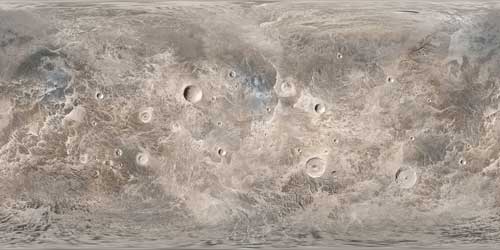| Aug 10, 2020 |
Revealing the Dawn of the dwarf planet Ceres
|
|
(Nanowerk News) Observations from the second extended Dawn mission to Ceres are presented in a suite of seven papers published this week in Nature Astronomy, Nature Geoscience and Nature Communications.
|
|
The findings suggest that Ceres is an ocean world and may have been geologically active in the recent past, shedding further light on the history and formation of the dwarf planet.
|
|
The Dawn spacecraft orbited Ceres — a dwarf planet and the largest known asteroid-belt object — from 2015 to 2018, before it ran out of fuel. In its final phase, the Dawn spacecraft orbited just 35 km above the surface of Ceres. It focused on the 20-million-year-old Occator crater, which had been shown earlier in the mission to exhibit bright deposits from brines coming from the interior.
|
 |
| Surface of Ceres. (click on image to enlarge)
|
|
In a Nature Astronomy paper, Carol Raymond and colleagues analysed high-resolution gravity data and imaging from Dawn and found that there is an extensive brine reservoir deep beneath the Occator crater. They suggest that the reservoir could have been mobilized by the impact that created the crater, which contributed to the formation of bright salt deposits on the planet’s surface.
|
|
In another paper, Maria Cristina De Sanctis and colleagues report the presence of hydrated chloride salts at the centre of Cerealia Facula, the biggest bright area in the center of Occator crater. As these salts dehydrate very quickly, the authors suggest that the brines may still be ascending, indicating that salty fluids could still exist in the interior of the dwarf planet.
|
|
In separate papers, Ryan Park and colleagues explore the make-up of Ceres’s crust, while Andreas Nathues and colleagues suggest that Ceres underwent a period of cryovolcanic activity starting around nine million years ago, and persisted until very recently.
|
|
Writing in Nature Geoscience, Britney Schmidt and colleagues show that the mounds and hills in the Occator crater may have formed when impact-induced water flows froze. This suggests that cryo-hydrologic processes extend beyond Earth and Mars, and were active on Ceres in the geologically recent past.
|
|
In two separate papers published in Nature Communications, Paul Schenk and colleagues suggest that water- and salt-rich mud-like impact melts are distinct from, and less expansive than, those on Mars, and Jennifer Scully and colleagues show that the various bright deposits in the Occator crater may have had different sources.
|
Full bibliography
|
|
Impact-driven mobilization of deep crustal brines on dwarf planet Ceres. DOI: 10.1038/s41550-020-1168-2
|
|
Recent cryovolcanic activity at Occator crater on Ceres. DOI: 10.1038/s41550-020-1146-8
|
|
Evidence of non-uniform crust of Ceres from Dawn’s high-resolution gravity data. DOI: 10.1038/s41550-020-1146-8
|
|
Fresh emplacement of hydrated sodium chloride on Ceres from ascending salty fluids. DOI: 10.1038/s41550-020-1146-8
|
|
Post-impact cryo-hydrologic formation of small mounds and hills in Ceres’s Occator crater. DOI: 10.1038/s41550-020-1146-8
|

